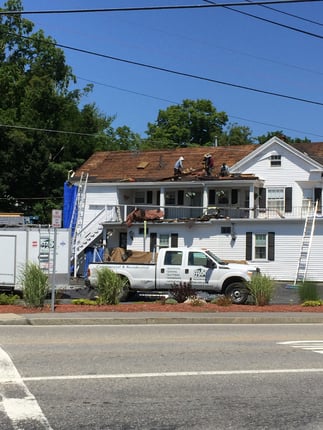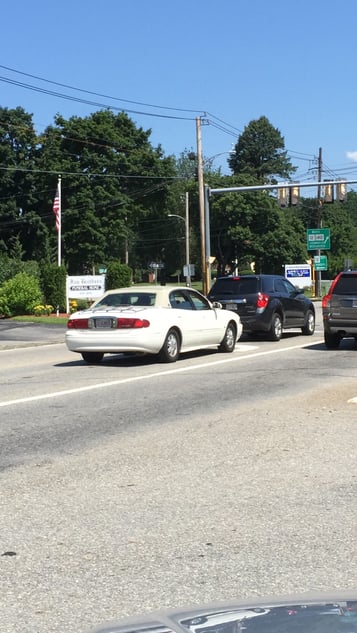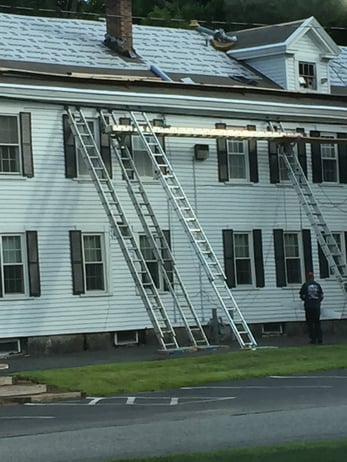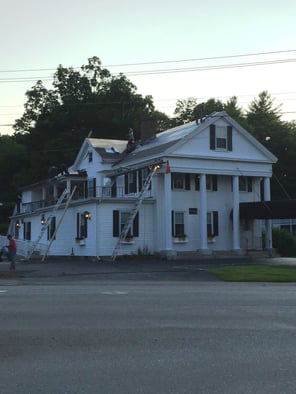Today, (7/11/2015) a fall protection training student sent me some video and pictures of a roofing crew working illegally in West Boylston, Mass. He said he is sick and tired of seeing roofing crews work without harnesses and safety protection when he makes his workers wear and use safety gear. He invested in the right equipment and fall protection training to protect his men. He said this is the right thing to do but adds cost to his projects. It is unfair that there is no level playing field out there.
He went on to say does OSHA work on the weekends?
This roofing crew was working on Saturday likely to avoid being visited by OSHA. They had a large crew of 10 plus men likely looking to get the job done in one or two days.
We see many contractors from the underground economy doing work on weekends without a permit and fall protection. These contractors entice homeowners by saying that they will save money if the work is done without a permit and scheduled on weekends when officials do not work. Some homeowners buy into this concept and hire these contractors.
Does OSHA work on weekends?
Great question but like most government agencies probably not!
From time to time we hear that an OSHA inspector stopped by a job on the weekend after noticing unsafe conditions. But this is the exception rather than the rule.

The pictures clearly show men working on a two story building with no safety equipment. They are at the edge stripping the roof. Then they are dropping waste to the ground where there are workers with no head protection. The ladder is set below the required 3 feet above the edge and it is not tied off. On the top left you will see some rope yet to be used.
The project is a funeral home in West Boylston, Mass. My client said he is going to do two things;
- Call the town to see if a permit was issued for the project.
- Call OSHA to report an Imminent Danger condition.
His reasoning;
"these are the types of projects where people get hurt or killed causing OSHA to continue to focus on residential contractors".
"These are the guys who come and go taking food of the table from guys who operate legally."
When reviewing the OSHA Data and Statistics web page one can see that OSHA is provided with complaints and referrals from outside sources.
Last month at the Hanley Wood Remodeling Leadership Conference OSHA said 25% of their job site visits come form complaints and referrals.

This picture shows the job is on a well traveled street. The picture when received by OSHA will make it easy for them to investigate the site and the company.
Other questions that came up in our conversation;
- Does the property owner have responsibility to make sure the contractor works safe?
- If the crew is a subcontractor is the general contractor accountable for worker safety of the sub?
In this case OSHA is first concerned with the employer of the men on the roof. They usually do not have jurisdiction over the building owner who hired a contractor. There job is to protect employees. However if the building owner is the general contractor he could be responsible for OSHA compliance on his site.
If the crew here is a sub-contractor OSHA can cite and fine both the sub-contractor and the Prime Contractor under the Multiple Employer Citation Policy.
It is prudent to make sure whenever you hire a sub-contractor you make sure they are following OSHA Safety protocol. This is important for any subs working up on heights; Roofers, Framers, Painters, Gutter and Siding Contractors and Masons.
The residential construction industry has always had underground economy contractors and homeowners willing to hire them to save a buck. This continues to plague our industry causing an uneven playing field rewarding illegal contractors while putting workers at risk.

Today a key difference is more and more safety compliant contractors, who do the right thing providing worker protection, are speaking up. They are frustrated when they see unsafe illegal contracting activity in their market areas. Many are sending in referrals to OSHA whenever they see this unsafe activity.
Note; OSHA actively allocates millions of dollars to promote whistle blowing from outside sources.

Sometimes when you see an army of guys up on a roofing, siding or painting job on a weekend, with out the proper fall and staging protection there is a good chance the job is being done then to avoid OSHA and local inspectors.
If they get the job done quick enough maybe no one will notice.
If you have question about following OSHA Fall Protection guidelines or need help with employee or subcontractor training and safety plans Contact Us.



